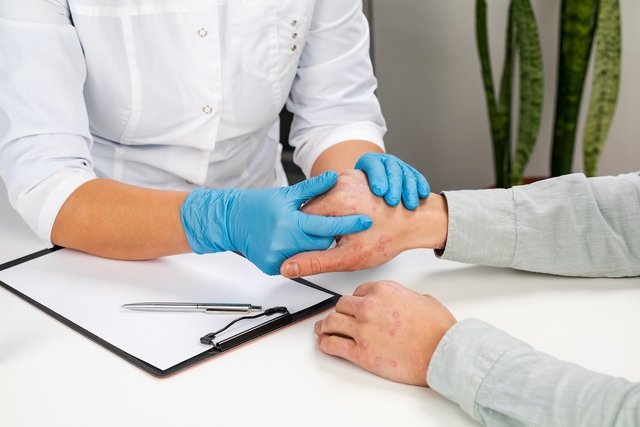Latex allergy is an abnormal reaction of the immune system to the proteins present in latex, which can occur in some people when they come into contact with this material, causing symptoms such as redness, itching, the formation of bumps on the skin or even difficulty breathing. which may appear immediately or 12 to 72 hours after contact with latex.
Latex is a substance extracted from the rubber tree, used to prepare various materials, such as gloves, balloons or condoms, for example, and a simple way to test if you are allergic to latex is to cut a finger from a latex glove and Then, wear this piece of glove on your finger for about 30 minutes. After this time, it should be noted whether any of the typical allergy symptoms have appeared.
The treatment of latex allergy should be guided by a general practitioner or allergist, and it is recommended to avoid prolonged contact with objects made from this type of material, or in some cases, use anti-allergic ointments to alleviate symptoms.

Latex allergy symptoms
The main symptoms of latex allergy are:
- Dry and rough skin;
- Intense itching;
- Redness;
- Swelling of the affected region;
- Formation of small blisters on the skin;
- Red or watery eyes;
- Sneezing;
- Feeling of a runny or stuffy nose.
It is important to consult your general practitioner or allergist whenever symptoms of latex allergy appear, so that a diagnosis can be made and treatment can be started, if necessary.
Furthermore, in some cases, latex allergy can be serious and cause an anaphylactic reaction, which requires immediate medical attention. Therefore, you should seek the nearest emergency room if symptoms such as difficulty breathing, swelling in the tongue, mouth or throat, dizziness, mental confusion, nausea, vomiting, or loss of consciousness appear. Know how to identify all the symptoms of an anaphylactic reaction.
Online symptom test
To find out the chances of having an allergy, such as latex allergy, please select the symptoms you are experiencing:
This test is a tool that serves as a means of guidance only. Therefore, it is not intended to provide a diagnosis and does not replace consultation with an allergist, immunologist or general practitioner.
How to confirm the diagnosis
The diagnosis of latex allergy is made by a general practitioner or allergist by evaluating symptoms, health history, as well as some blood tests to assess the presence of some specific types of antibodies. Find out more about tests to identify allergies.
In addition, the doctor may request an allergy test, which is carried out in the doctor’s office by applying different substances to the skin, to check the emergence of symptoms and thus confirm the diagnosis.
Possible causes
Latex allergy is caused by an exaggerated response of the immune system to proteins present in latex, causing the body to produce antibodies against these proteins or inflammatory substances in the body, such as histamine, which leads to the appearance of symptoms. The main latex products that can cause allergies are:
- Condoms;
- Surgical and cleaning gloves;
- Toys with flexible rubber;
- Party balloons;
- Diaphragm;
- Menstrual collector;
- Baby bottle nipples;
- Pacifiers;
- Clubs used for blood tests;
- Dental products, such as orthodontic elastics;
- School supplies such as erasers, rubber bands or tape.
Anyone can develop sensitivity or allergy to latex, especially when they have daily or frequent contact with this material, as in the case of nurses and doctors, gardeners, cooks, beauty professionals and construction workers, for example.
Additionally, people who are allergic to foods such as avocado, tomato, kiwi, figs, papaya, walnuts and bananas generally also have a higher risk of having a latex allergy. In addition, it is also common to be allergic to dust, pollen and animal hair.
How the treatment is carried out
People with latex allergies should, whenever possible, avoid contact with this type of material, especially for long periods, giving preference to equipment made from other materials such as polyethylene or polyvinyl gloves, for example. In the case of condoms, you should opt for a latex-free condom, which is sold in pharmacies.
Furthermore, in cases where there is a more severe reaction to latex, the doctor may also prescribe some antihistamine or corticosteroid ointments to alleviate symptoms.
In the case of a severe allergic reaction or anaphylactic shock, treatment is carried out in the hospital, with an injection of epinephrine, in addition to intravenous serum, applied by a nurse under medical supervision. See how anaphylactic shock is treated.
Bibliography
- RAULF, M. Current state of occupational latex allergy. Curr Opin Allergy Clin Immunol. 20. 2; 112-116, 2020
- NUCERA, E.; et al. Latex Allergy: Current Status and Future Perspectives. J Asthma Allergy. 13. 385-398, 2020
- PARISI, CAS; et al. Update on latex allergy: New insights into an old problem. World Allergy Organ J. 14. 8; 100569, 2021
- GOSH NHS. Latex allergy. Disponível em: <https://www.gosh.nhs.uk/conditions-and-treatments/conditions-we-treat/latex-allergy>. Acesso em 08 mai 2020
- AMERICAN COLLEGE OF ALLERGY, ASTHMA & IMMUNOLOGY. Latex Allergy. Available at: <https://acaai.org/allergies/types/latex-allergy>. Accessed on May 8, 2020
- ASTHMA AND ALLERGY FOUNDATION OF AMERICA. Latex Allergy. Available at: <https://www.aafa.org/latex-allergy/>. Accessed on May 8, 2020

Sign up for our newsletter and stay up to date with exclusive news
that can transform your routine!
Warning: Undefined array key "title" in /home/storelat/public_html/wp-content/plugins/link-whisper-premium/templates/frontend/related-posts.php on line 12
Warning: Undefined array key "title_tag" in /home/storelat/public_html/wp-content/plugins/link-whisper-premium/templates/frontend/related-posts.php on line 13



